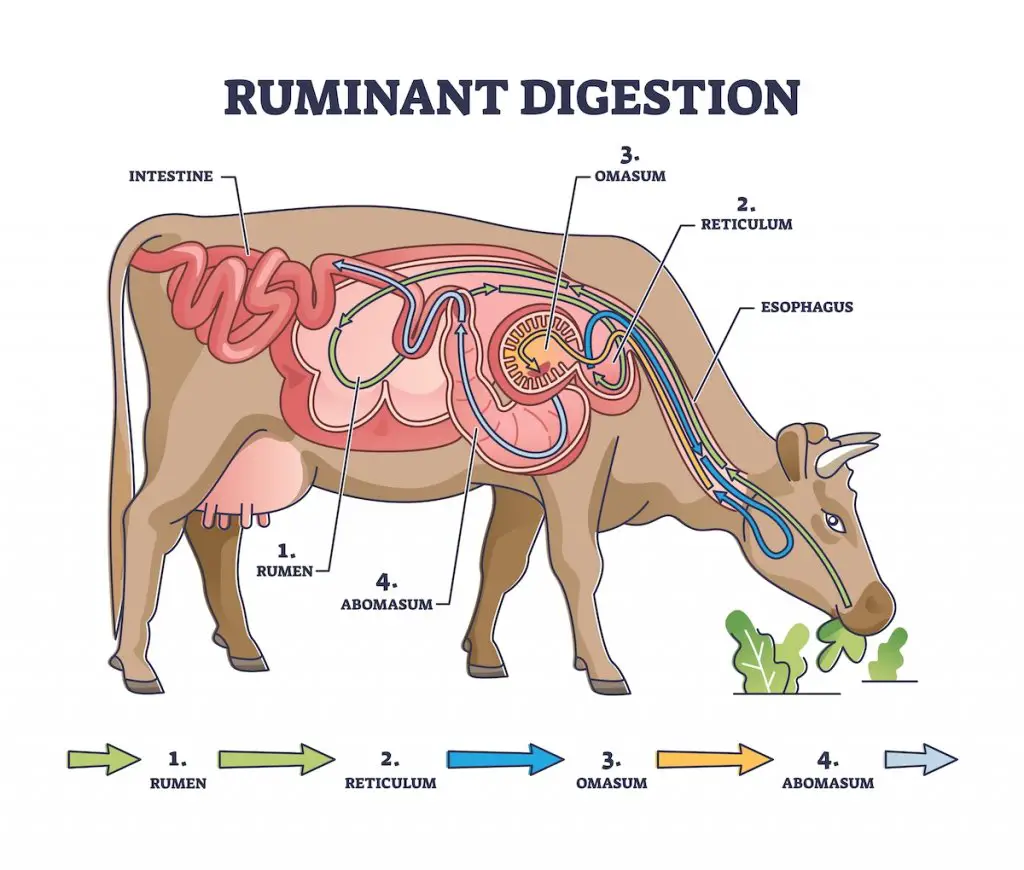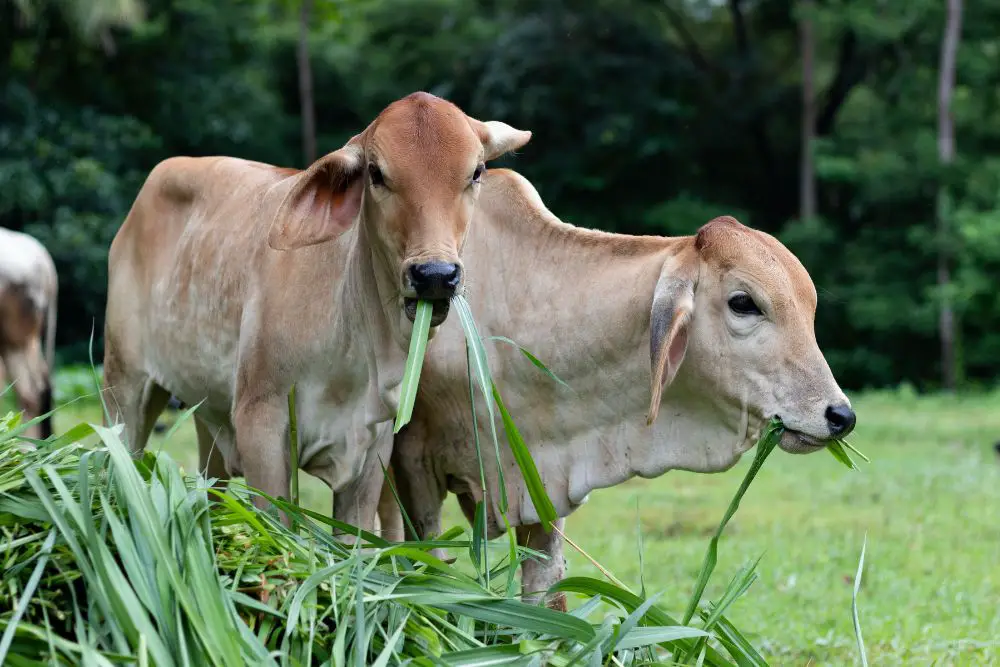A cow eats grass because it is biologically designed for eating grass. A cow’s stomach has four compartments (the rumen, the reticulum, the omasum, and the abomasum) and each compartment performs particular tasks. Cows also feed on legumes, grains, and silage.
This article discusses the reasons why cows eat grass, the common types of grass they prefer, other plant materials that cows can eat, and the benefits and nutrients cows get from grass.
Table of Contents
Reasons Why Cows Eat Grass
1. Cows Are Ruminants And Are Designed For Eating Grass
The whole process starts when a cow takes its first bite of grass. The grass is chewed a little before swallowing. The swallowed grass enters the first compartment known as the rumen (the largest of the four compartments of the cow’s stomach) where it is stored waiting for the rumination process.

The previously consumed grass is ‘un-swallowed’ back, re-chewed again to break the matter into small particles for ease of digestion, then re-swallowed back into the rumen where digestion then begins. This whole process is called rumination, better understood as ‘chewing the cud.’
2. Grass Is Found In All Parts Of The World
Since grass is readily available, it can be eaten in its original form or can be harvested when dry and stored to be fed later to cows.
Common Types Of Grass Cows Prefer
There are two main types of grasses: perennial and annual. Perennial grasses are ones that grow for more than two years, such as Bermuda grass and Timothy grass. Annuals are those that grow for one season.
| Grass Type | Description |
| Bermuda | This perennial type of grass can withstand heavy grazing because it has better wear, salt, and drought tolerance. It can surpass most species of weeds and grows rapidly. It thrives best in warm tropical climates. It turns completely brown during winter but this is temporary because it regains its green color when warm weather returns. |
| Bahia | Bahia grass is a perennial type of grass that grows in warm climates just like Bermuda grass. It tolerates heavy grazing and drought and is free from severe disease and insect infestation, being around 50% digestible and 8% of crude protein. |
| Brachiaria | Brachiaria grass (better known as Palisade Grass) is native to Africa and was introduced to America and Australia in the 1800s, and has a protein content of 9-20%. It should be harvested before flowering because its nutrition percentage decreases as it matures. |
| Ryegrass | Ryegrass is a high-quality type of grass adapted to mild temperatures. It is 70% digestible and has a crude protein of 20%. |
| Napier | Napier grass is a perennial type of forage that is native to Africa but also grown in other tropical countries. It is also known as Elephant Grass since it’s also a favorite food for elephants. It is low maintenance, grows easily, withstands prolonged drought periods and frequent cutting, and immediately starts to grow quickly when rain periods begin. It is 55-58% digestible, has a crude protein of 8-12%, and crude fiber of 26-28%. |
Other types of grass suitable for cows include Reed Canary, Fescue, Scutch Grass, Kentucky Bluegrass, Timothy Grass, Quack Grass, and Foxtail Grass.
Other Things That Cows Eat
Besides grass, cows can eat legumes, grain, and silage:
| Food Type | Description |
| Legumes | Legumes are a type of plant high in protein and fiber. They include alfalfa (lucerne), lentils, and clover. Legumes are known to increase milk production in dairy cows. |
| GrainsGrains include corn, sorghum, oat, and wheat. Grains should be fed to cows in small amounts because they can cause disturbances in the digestive system. The energy value in grains varies depending on the type of grain. For example, corn is higher in energy than oats. Oats have high fiber content but low energy levels so they’re considered safe for cows in terms of causing digestive issues. | |
| Silage | Silage is made from a combination of different grasses and legumes, which are left out to ferment and then cut into small pieces. |
Cows can also eat food processing by-products obtained from milling, brewery, vegetable and fruit processing, and distillery.
Benefits and Nutrients Cows Get From Grass
Grass is a staple for cows as it contains dry matter and water content, although water content is more compared to dry matter. For example, 100 kgs of fresh grass might actually contain around 83 kgs of water and 17 kgs of dry matter.
The dry content contains fiber, protein, carbohydrates in form of cellulose, sugar, iron, minerals, and vitamins. Sugar and fiber provide energy with the help of some protein and oil.

The protein in grass helps with milk production, growth, and appetite. Grass contains 16-28% protein. The protein quantity depends on the time of the year, growth stage, and the type of fertilizer used.
The fiber in grass helps cows to maintain a healthy rumen. Dairy cows need more fiber than beef cattle.
The minerals in grass can be divided into two elements, major and trace:
| Major elements | Sodium, calcium, sulfur, and magnesium |
| Trace elements | Manganese, iodine, copper, zinc, and selenium |
Grass has low levels of trace elements so grass-fed cattle should be supplemented with minerals during breeding, calving, and the tetany period.
How Much Grass Do Cows Eat?
Cows consume 2.5-3% of their body weight per day, which means that if an average cow weighs 1,200 pounds, it will eat roughly 30-36 pounds of grass per day.
A cow’s digestive system is designed to eat grass. Cow stomachs contain special microbes that help break down plant matter. These microbes are able to digest the fibers in grasses and other plants that humans can’t digest.
Do Cows Eat Grass In The Winter?
Yes, grass-fed cows do eat grass in the winter. But they don’t just eat any old grass – they eat it in the form of hay which is made up of dried grasses and other plants that have been harvested and stored for later use.
Hay is fed to cattle as a substitute for fresh grass during the cold winter months when it’s too wet or simply snowing outside to graze on fresh pastureland.
